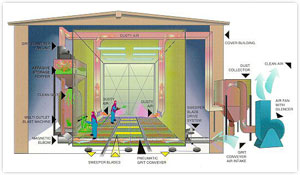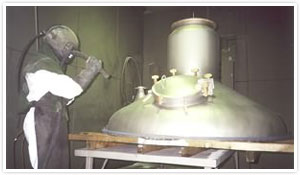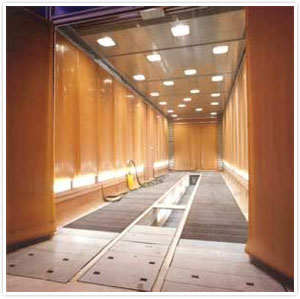Epcoat > Industrial > Standard Products > Shot Blasting
Shot Blasting
Abrasive blasting is a method of propelling abrasive using a compressed gas (typically air) or pressurized liquid (typically water) as the propellant. There are numerous generic terms for this application usually related to the abrasive media used. Common terms include bead blasting, sandblasting, shot blasting, grit blasting.
The large variety of applications creates the need for a diversity of equipment:
Portable blast equipment (aka blast pot):
Dry abrasive blasting applications are typically powered from a diesel air compressor. Most applications involve a pressurized vessel that contains the abrasive and meters it into the compressed air stream. Wet blasting is accomplished by injecting the abrasive into a pressurized water stream or creating a slurry of abrasive and water that is pressurized or introduced into a compressed air stream. Wet blasting is often used in applications where the minimal dust generation is desired and areas are full with combustible atmosphere (. Portable applications may or may not recycle the abrasive and portable dry blasting generally does not attempt to contain or minimize the dust generated from the operation.
Automated blasting :
A fully automated blasting provides surface preparation and coating applications under cover to minimize the effects nature can have on prepared steel, with minimum or no impact to the environment.
Blast cabinet:
A blast cabinet is essentially a closed loop system that allows the operator to blast the part and recycle the abrasive. A typical blast cabinet consists of four components; the containment (cabinet), the abrasive blasting system, the abrasive recycling system and the dust collection. The operator blasts the parts from the outside of the cabinet by placing his arms in gloves attached to glove holes on the cabinet, viewing the part through a view window and, typically, turning the blast on and off using a foot pedal or treadle. Automated blast cabinets are also used to process large quantities of the same component and may incorporate multiple blast nozzles and a part conveyance system.
There are three types of blast systems used in a blast cabinet. Two systems (siphon and pressure) are dry and one is wet:
A siphon blast system (aka suction blast system) uses the compressed air to create vacuum in a chamber (known as the blast gun). The negative pressure pulls abrasive into the blast gun where the compressed air directs the abrasive through a blast nozzle.
A pressure blast system incorporates a pressurized vessel. The abrasive is stored in the pressure vessel then sealed. The vessel is pressurized to the same pressure as the blast hose attached to the bottom of the pressure vessel. The abrasive is metered into the blast hose and conveyed by the compressed gas through the blast nozzle.
Wet blast cabinets use a slurry system that injects the slurry into a compressed gas stream. Wet blasting is typically used to create a surface profile when the frictional heat of dry blasting would damage the part.
Blast room:
This is a larger version of a blast cabinet with the exception that the blast operator works inside the room. A blast room always has three of the four components of a blast cabinet: the containment, the abrasive blasting system and the dust collector. Most blast rooms have recycling systems ranging from manual recycling (sweeping and shoveling the abrasive back into the blast pot) to full reclaim floors that convey the abrasive pneumatically or mechanically to a device that cleans the abrasive prior to recycling.
Abrasive blasting is a method of propelling abrasive using a compressed gas (typically air) or pressurized liquid (typically water) as the propellant. There are numerous generic terms for this application usually related to the abrasive media used. Common terms include bead blasting, sandblasting, shot blasting, grit blasting.
The large variety of applications creates the need for a diversity of equipment:
Portable blast equipment (aka blast pot):
Dry abrasive blasting applications are typically powered from a diesel air compressor. Most applications involve a pressurized vessel that contains the abrasive and meters it into the compressed air stream. Wet blasting is accomplished by injecting the abrasive into a pressurized water stream or creating a slurry of abrasive and water that is pressurized or introduced into a compressed air stream. Wet blasting is often used in applications where the minimal dust generation is desired and areas are full with combustible atmosphere (. Portable applications may or may not recycle the abrasive and portable dry blasting generally does not attempt to contain or minimize the dust generated from the operation.
Automated blasting :
A fully automated blasting provides surface preparation and coating applications under cover to minimize the effects nature can have on prepared steel, with minimum or no impact to the environment.
Blast cabinet:
A blast cabinet is essentially a closed loop system that allows the operator to blast the part and recycle the abrasive. A typical blast cabinet consists of four components; the containment (cabinet), the abrasive blasting system, the abrasive recycling system and the dust collection. The operator blasts the parts from the outside of the cabinet by placing his arms in gloves attached to glove holes on the cabinet, viewing the part through a view window and, typically, turning the blast on and off using a foot pedal or treadle. Automated blast cabinets are also used to process large quantities of the same component and may incorporate multiple blast nozzles and a part conveyance system.
There are three types of blast systems used in a blast cabinet. Two systems (siphon and pressure) are dry and one is wet:
Blast room:
This is a larger version of a blast cabinet with the exception that the blast operator works inside the room. A blast room always has three of the four components of a blast cabinet: the containment, the abrasive blasting system and the dust collector. Most blast rooms have recycling systems ranging from manual recycling (sweeping and shoveling the abrasive back into the blast pot) to full reclaim floors that convey the abrasive pneumatically or mechanically to a device that cleans the abrasive prior to recycling.





